On the firefront: Aussies lend expert hand to battle US blazes
Nick Moir has joined NSW RFS members and thousands of firefighters from across the US who are attempting to slow the destructive progress of the raging California Fire Park fires.
By Nick Moir
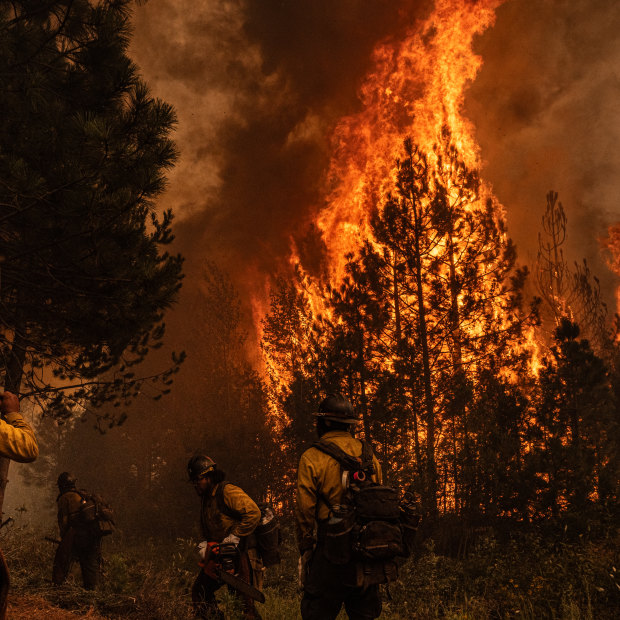
The American River Hotshot crew retreat as flames jump their containment line.Credit: Nick Moir
The California Park Fire raging in the north of the state was started by an arsonist on July 24 and has to date destroyed more than 600 buildings, with its cost climbing to $US170 million ($256 million) and counting. I have joined NSW RFS members and a contingent of thousands of firefighters from across the US attempting to slow its progress.
ANATOMY OF THE FIRE
The Californian town of Cohasset is strung along a road winding its way into the mountains, looking down onto the Sacramento Valley. The drive up to the town starts as yellow cured grassland, then becomes partial timber until it thickens into forest.
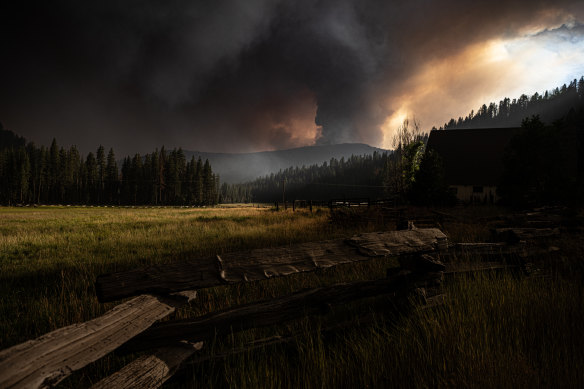
The tranquil scene in the foreground is menaced by a huge rotating fire column. Credit: Nick Moir
Blackened rock and the skeletal remains of pines are all that is left, with a few tufts of pine needles frozen in the position they were in when the fire came through – a phenomena called leaf freeze.
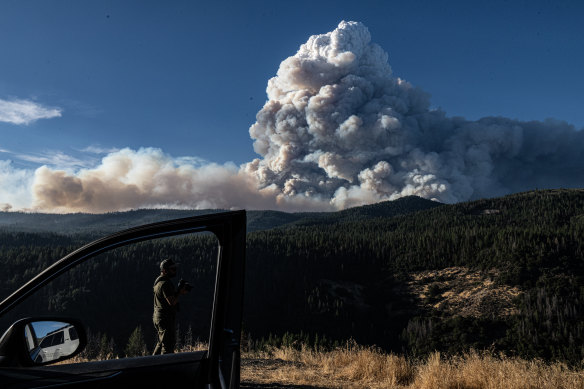
The huge pyrocumulous smoke column from the Park Fire.Credit: Nick Moir
For this Sydneysider it is eerily reminiscent of towns like Bilpin, Clarence and Bell in the Blue Mountains during the bushfires in 2019.
The California fire is still burning in the alpine areas of the state’s north-east, where the top altitude is more than 1500 metres.
The fire started in grassy scrubland, similar to parts of south-western Sydney like Luddenham, and raced up the canyons into higher country. It is continuing to burn in the national forest, where Ponderosa pines tower higher than anything we have in NSW.
The fire was thought to be subsiding but roared back to life on August 5 when it found its way into a box canyon and became so powerful it created a pyrocumulonimbus cloud and a fire tornado, as seen during the Canberra fires of 2003.
As hundreds of fires across the US’s north-west begin to overwhelm firefighting resources, the US made a request to Australian fire agencies to help fill the gaps in roles such as taskforce leadership.
RFS volunteer Stuart Dawson, who bounces between a home in Sydney’s northern beaches and a farm near Mudgee, is in charge of a taskforce of very chatty and good-natured forestry workers operating huge tree harvesting machinery. They are preparing a secondary containment line near the town of Oakridge, in mountainous and heavily forested southern Oregon.
“I love fighting fire in different countries, it’s like one big family. Everyone’s very welcoming, very thankful you have come such a long way to help them out,” Dawson says.
Operations officer Dane Freeman, from Kenthurst, has the role of safety officer, alongside experienced RFS officer Cameron Wade. Freeman has been assigned to the Coffeepot fire and is moving around taskforces trying to anticipate any avoidable threats to the safety of crews working in steep terrain.
During a brief chat with the Herald, one US wildlife officer mentions that cougars and black bears are in the area, but the yellow jacket wasps pose the most common wildlife threat as they escape the fires.
During the patrol of a “slopover”, where the fire has been able to crest a mountain and make its way downhill, we hear the crack and crash of collapsing pines and firs, a reminder that one of the biggest dangers to a firefighter anywhere in the world is falling trees.
Hundreds of millions of dollars have been spent fighting the fire, and thousands of firefighters from across the country deployed to stall its progress.
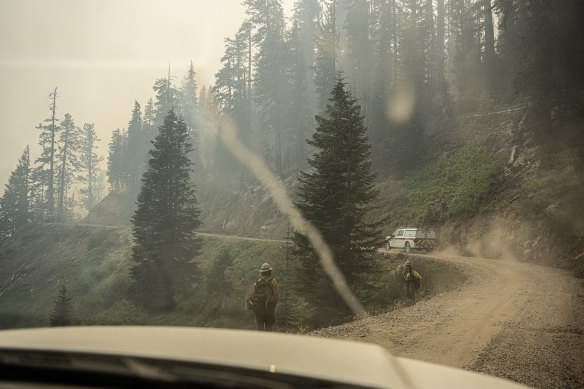
Australian firefighters have been deployed to Oregon and Washington states in the US.Credit: Nick Moir
The lack of rain has allowed the fire to continue to smoulder even as temperatures drop. The southern edge of the fire is only a few kilometres from the town of Paradise, which was completely destroyed a few years ago when the Camp fire killed 85 people in a disaster similar to the events in Kinglake, Victoria on Black Saturday in 2009.
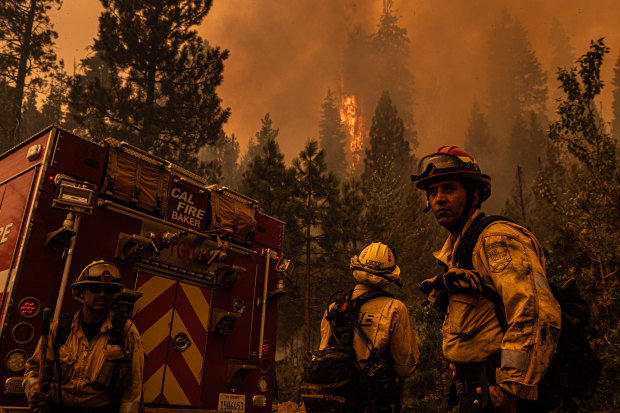
A CalFire crew assesses a spot fire near Mill Creek, California.Credit: Nick Moir
While there are many similarities in the fire behaviour and scale of the disasters that have hit south-east Australia and the western US, the fire agencies are quite different in the way they approach and fight a major wildfire.
With just a day of preparation involving orientation and situation briefings, and the issuance of protective gear and equipment, the RFS team hit the ground running. It has been deployed to numerous fires in the Pacific Northwest, and all members have the required skill set and experience to provide safety and supervision consistent with US standards.
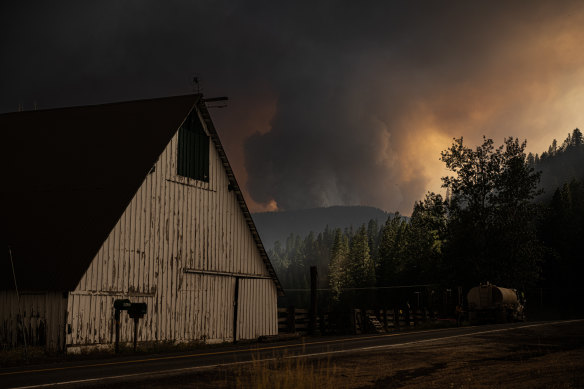
A huge, rotating fire column hangs over the mountain.Credit: Nick Moir
The deployment of 71 specialists from Australia and New Zealand is just the most recent example of the collaborative relationship with US fire agencies. NSW RFS Director of Logistics Joshua Torrens says this continues to demonstrate the co-operation between the countries. Torrens says the 24-year relationship evolved from a request from the United States in 2000.
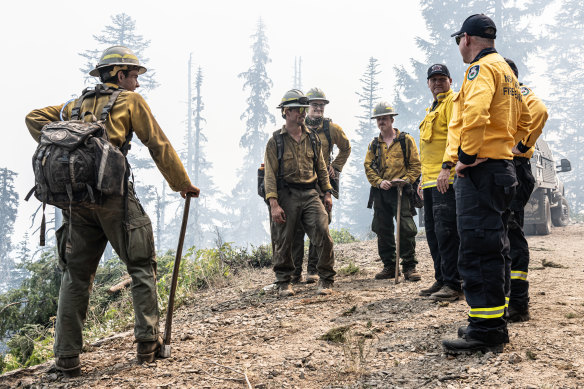
RFS staff member Dane Freeman briefs a crew at the edge of the Moss Mountain fire. Credit: Nick Moir
“The fire community, not only domestically but internationally, is a very close community and we appreciate the invitation to support and the opportunity to return the favour. There have been multiple deployments from both sides to assist with fires, the most notable for the US was back in 2019-20 assisting Australia with the Black Summer fires,” he says.
Australian fire agencies make extensive use of fire trucks along with heavy plant and firefighting aircraft, including the “Marie Bashir” of the NSW RFS, which has been deployed in California.
Australian captain-in-training Tony Frank is in the cockpit of the 737 on its fourth and busiest US deployment. His mission is to create containment lines and slow the spread of the fire, allowing the ground crews to knock down the fire flanks. The Herald watched the aircraft make many sorties over the blaze. US crews were curious about the RFS markings.
The Australian contingent will remain in the US for about another four weeks, with another team likely to replace them. However, the bonds between the firefighters and the lesson learnt from working together will endure for many fire seasons to come.
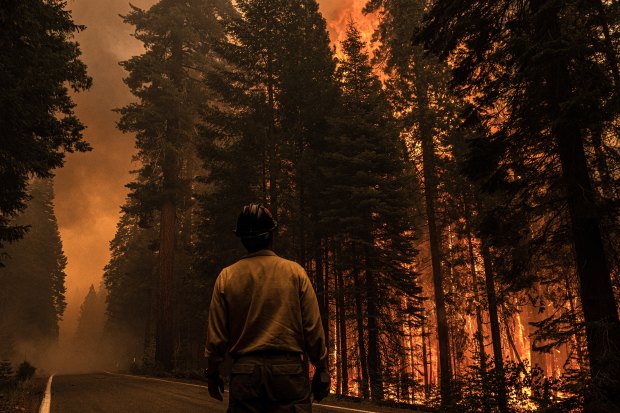
A Californian firefighter watches massive fir trees go up in flames near Mill Creek.Credit: Nick Moir